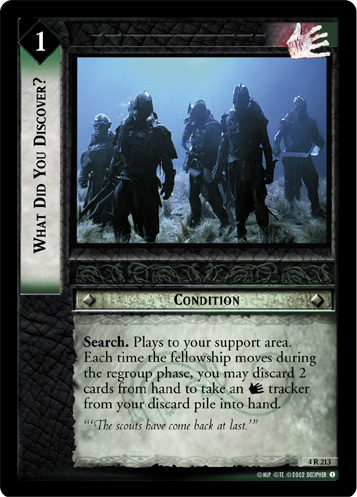What Did You Discover? (4R213)
Back to The Two Towers Index |
Where Has Grima Stowed It? (4R214) |
What Did You Discover? (4R213) is a Isengard Condition from the The Two Towers set. In many ways it is the Isengard version of Spies of Mordor (2U92)
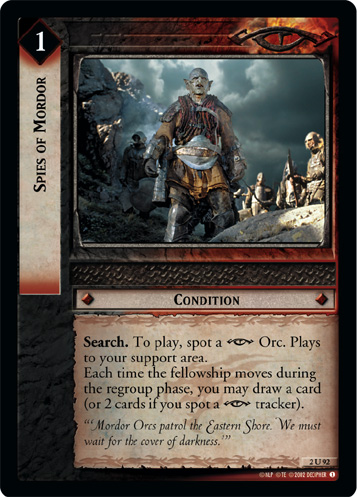 .
.
| ||||||||||||||||||
| ||||||||||||||||||
| ||||||||||||||||||
Strategy[edit]
Gameplay Strategy[edit]
This card addresses a core problem for any Shadow side: players move during the regroup phase knowing however many cards each Shadow player has drawn, about half of them are probably Free Peoples cards and not a threat. This is especially true towards the end of the game, where the high shadow numbers on sites can act as a soft signal for how many Free Peoples cards are in a Shadow player's hand after the first move. What Did You Discover? can exchange two unplayable or undesirable cards for the best minion in the Shadow player's discard pile, a potentially daunting proposition when combined with whatever else may be in hand. The mere threat that this card can pose may be enough to keep a player from moving in the regroup phase at all, making it one of few cards that can have an impact on a game even without being used.
While a move in the regroup phase to site 3 is common, at sites 1-4 there is not much opportunity to use this card. Uruk-hai are roaming and shadow numbers are low, limiting how many minions can be played and leading to a hand already stacked with Shadow cards. This also means there usually isn't a good selection of minions in the discard pile anyway. These factors tend to naturally allow Uruk-hai to play a strong site 5, which should both make it nearly impossible for an opponent to move in the regroup phase and almost guarantee a stop at site 6 to heal at the sanctuary. As a result, the earliest - and often only - opportunity to really get value out of this card most of the time is a move in the regroup to site 8 or 9. This is also when all the factors that worked against its use at the start of the game instead work for it: no roaming penalty, high shadow numbers, plenty of Shadow cards are cycling out of the hand in the initial move, and choice minions in the discard pile.
On rare occasion, a player may benefit from using What Did You Discover? without playing the minion taken back from the discard pile. With the last copy of Uglúk, Servant of Saruman (4R176)
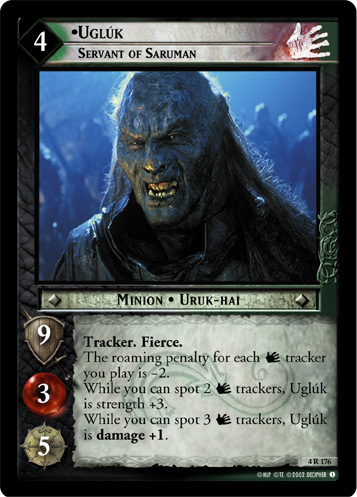 in hand or in play, it may make sense to pull a copy for the next site. If an opponent is able to double to site 6, the low shadow number of the sanctuary may not allow enough twilight to do any lasting harm. Taking the right minion back into hand in preparation for site 7 can help ensure the Free Peoples player regrets jumping out ahead. In a game with 3 or more players, the ability can allow you to curate a killer hand in turns where you aren't left enough twilight to play anything meaningful.
in hand or in play, it may make sense to pull a copy for the next site. If an opponent is able to double to site 6, the low shadow number of the sanctuary may not allow enough twilight to do any lasting harm. Taking the right minion back into hand in preparation for site 7 can help ensure the Free Peoples player regrets jumping out ahead. In a game with 3 or more players, the ability can allow you to curate a killer hand in turns where you aren't left enough twilight to play anything meaningful.
The effect may be used once per copy, and since the Fellowship chooses whether to move immediately after all Shadow players reconcile it is always possible to pay the cost of this effect. At the same time, this means that any cards discarded will not be replenished. While getting rid of two cards is often beneficial (especially towards the end of the game, when players have a clearer picture of what they can get rid of and what they need to draw), four cards may force a player to sacrifice an otherwise playable card or lose out on a key Free Peoples card. Using three or four copies can ensure a solid showing of minions, but remember that Isengard trackers cap out at 12 strength without pumps which on its own may not be enough against the sort of deck that is capable of attempting a double move in the first place.
That said, extra copies can still be useful even if you don't plan on using the effect multiple times -- namely to replace copies that are discarded (including from your own Saruman's Power (1U136)
 ). This is especially true if the primary function of the Shadow side is not to win directly, instead focusing on keeping your opponent behind. Such a deck also gains an outsized benefit from the discarding -- there isn't the temptation to keep the "right" Shadow cards in hand if you aren't trying to win with your Shadow. By discarding what other players would hold on to for the right moment, you allow more Free Peoples cards to be drawn and bolster your own run in turn.
). This is especially true if the primary function of the Shadow side is not to win directly, instead focusing on keeping your opponent behind. Such a deck also gains an outsized benefit from the discarding -- there isn't the temptation to keep the "right" Shadow cards in hand if you aren't trying to win with your Shadow. By discarding what other players would hold on to for the right moment, you allow more Free Peoples cards to be drawn and bolster your own run in turn.
Above all else, remember that using this card depends (almost) entirely on choices the Free Peoples player makes. If your opponent is ahead of you on the site path, there may never be a need to risk a double move by the time What Did You Discover? is played. Even so, this can play into the Shadow player's favor from time to time: if your decides to stop at 8 rather than risk running against a perfect Shadow hand, you may be given an opportunity to double from 7 to 9 that wouldn't otherwise have presented itself.
Deckbuilding Strategy[edit]
Since this card is most useful later in the game and the cost is rarely worth paying multiple times, a streamlined deck may need only one copy. This does make it vulnerable to being discarded before it can be used, and since many Isengard decks already include Saruman's Power (1U136)
 you may wind up discarding it yourself. More copies provide redundancy at the cost of consistency for the rest of your deck -- most of the time, any other Shadow card will have greater impact than a copy of What Did You Discover? when one is already on the table.
you may wind up discarding it yourself. More copies provide redundancy at the cost of consistency for the rest of your deck -- most of the time, any other Shadow card will have greater impact than a copy of What Did You Discover? when one is already on the table.
Abandoning Reason for Madness (3C49)
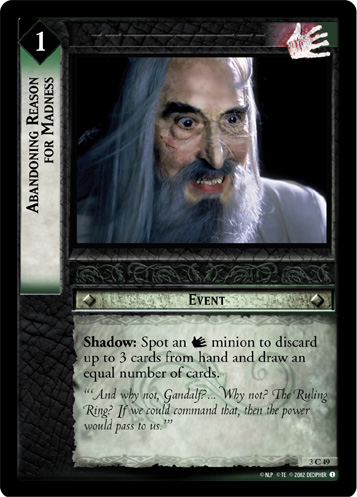 can sometimes serve a similar role without the same restrictions and may be preferred, though less efficiently since some cards drawn will be Free Peoples (playing it and discarding 3 other cards from hand costs 4 cards and will optimistically get 2 Shadow cards, the same as using two copies of What Did You Discover? which gets two minions guaranteed). Minion-heavy decks will typically do just as well with either, almost always able to spot a minion and likely to draw more. Conversely, decks with more supporting cards are less likely to find a minion with it (if that is your goal) and -- in a particularly lopsided deck or reconcile -- may not be able to spot a minion to play it when it is needed most. Perhaps unintuitively, the exact makeup of the minions does not need to be a deciding factor in choosing between the two: if there is a tracker you want to replay should the Free Peoples player make again, it will probably wind up in the discard pile before site 8 for a Shadow side close to the minimum 30 cards.
can sometimes serve a similar role without the same restrictions and may be preferred, though less efficiently since some cards drawn will be Free Peoples (playing it and discarding 3 other cards from hand costs 4 cards and will optimistically get 2 Shadow cards, the same as using two copies of What Did You Discover? which gets two minions guaranteed). Minion-heavy decks will typically do just as well with either, almost always able to spot a minion and likely to draw more. Conversely, decks with more supporting cards are less likely to find a minion with it (if that is your goal) and -- in a particularly lopsided deck or reconcile -- may not be able to spot a minion to play it when it is needed most. Perhaps unintuitively, the exact makeup of the minions does not need to be a deciding factor in choosing between the two: if there is a tracker you want to replay should the Free Peoples player make again, it will probably wind up in the discard pile before site 8 for a Shadow side close to the minimum 30 cards.
While it is appealing on paper for a strategy prioritizing Shadow kills, remember that by trailing behind to play your sites, you disincentivize your opponent from ever moving in the regroup phase. Unless your game plan is to jump ahead of your opponent at the last moment (for example, stopping them at site 8 and moving from 7 to 9 yourself), it is best paired with a Free Peoples that will keep an opponent trying to catch up.
Strengths and Weaknesses[edit]
Synergizes With...[edit]
- A solid Free Peoples that often goes first or can make bold moves later in the site path
Strong Versus...[edit]
- Radagast, The Brown (9R+26)
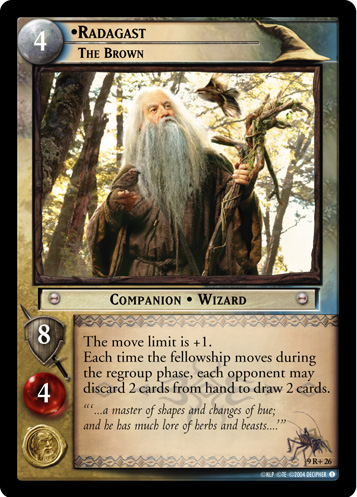 -- you may take advantage of his free cycling before deciding whether to use What Did You Discover?
-- you may take advantage of his free cycling before deciding whether to use What Did You Discover? - Certain discard strategies such as What Are We Waiting For? (2R15)
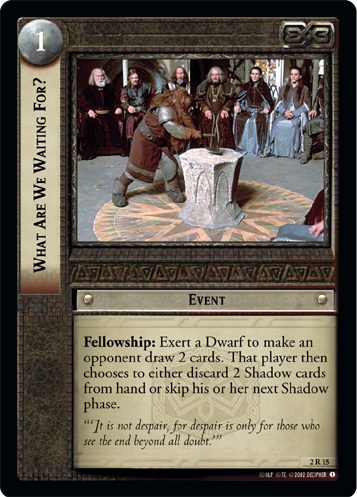 or Far-seeing Eyes (1C43)
or Far-seeing Eyes (1C43)
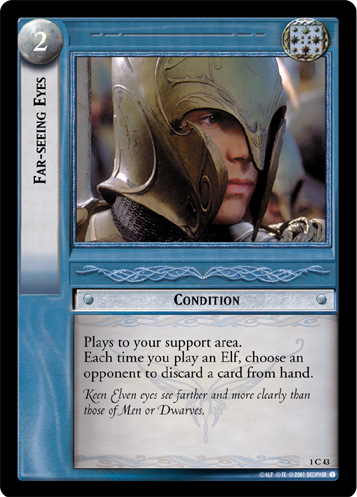 , which will sometimes completely wipe out a Shadow player's hand in the Fellowship phase and double
, which will sometimes completely wipe out a Shadow player's hand in the Fellowship phase and double - Ents, which typically try to dump twilight and move faster than an opponent can play cards and don't often get above 12 strength
- Sprinting decks (e.g., Drawing His Eye (10R29)
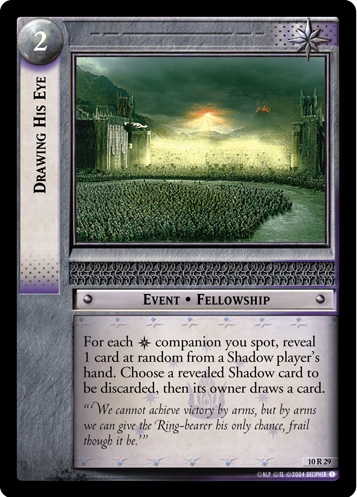 + Last Throw (10C34)
+ Last Throw (10C34)
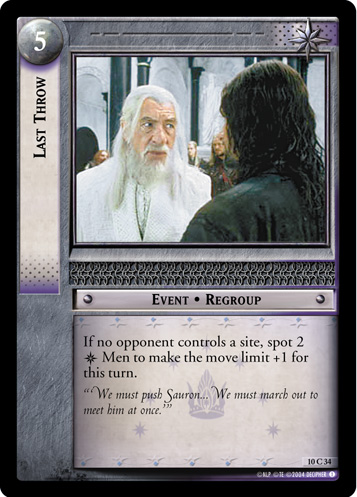 ), which hope to clog the Shadow player's hand with Free Peoples cards and then make three or more moves in one turn to end the game
), which hope to clog the Shadow player's hand with Free Peoples cards and then make three or more moves in one turn to end the game
Weak Versus...[edit]
- Fearing the Worst (2R100)
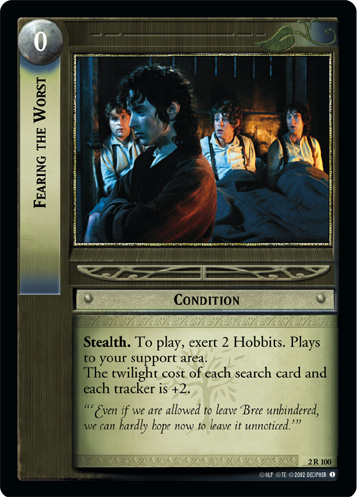 -- Saruman's Power is the most natural condition discarding for most Isengard decks, and getting rid of this one Free Peoples condition outweighs the cost of losing any number of Shadow conditions for a Tracker deck
-- Saruman's Power is the most natural condition discarding for most Isengard decks, and getting rid of this one Free Peoples condition outweighs the cost of losing any number of Shadow conditions for a Tracker deck - Galadriel, Lady Redeemed (10R11)
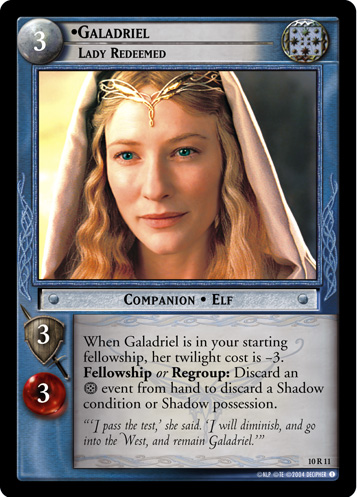 , who can reliably discard it in the regroup phase when the Free Peoples is assessing whether they can attempt to move again
, who can reliably discard it in the regroup phase when the Free Peoples is assessing whether they can attempt to move again
See Also[edit]
Decks[edit]
"Fear This" - Michael Dalton's Worlds 2003 Champion deck[edit]
- Format: Towers Standard
- Ring-bearer: Frodo, Tired Traveller (4C302)
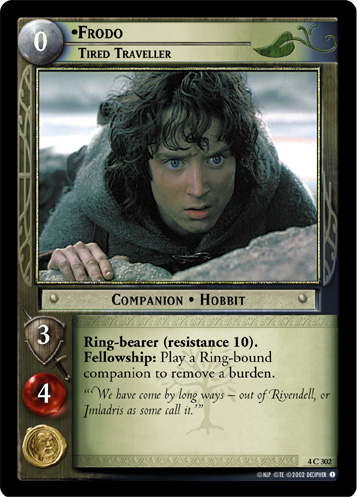
- Ring: The One Ring, Answer To All Riddles (4R1)
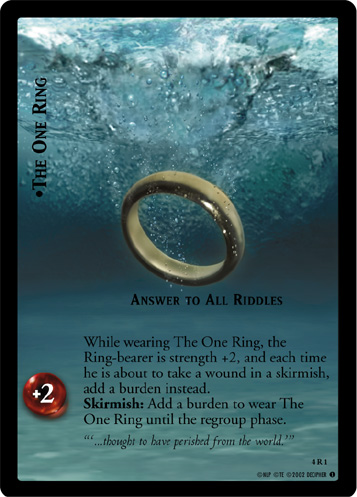
Adventure deck:
- Eastemnet Gullies (4U325)
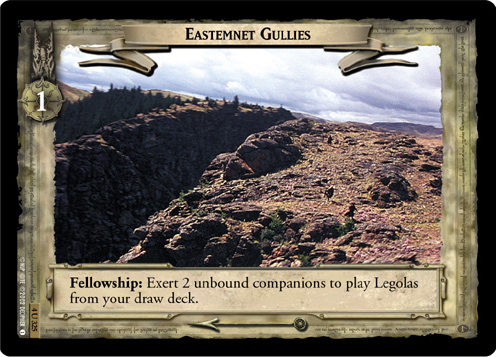
- Wold of Rohan (4U336)
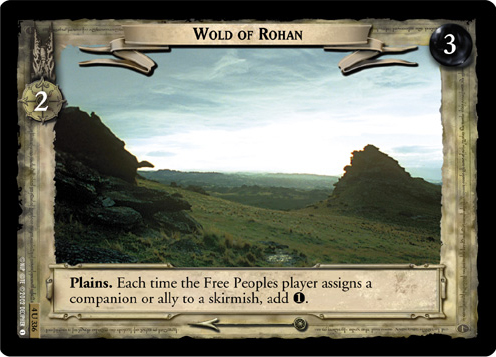
- Stables (4U339)
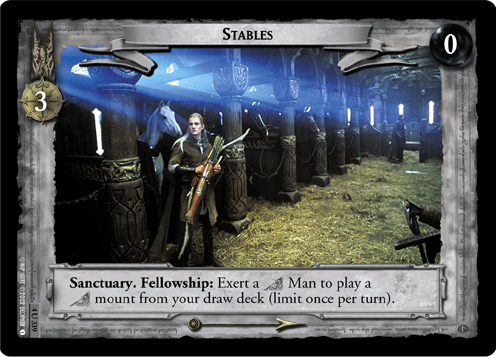
- Westemnet Hills (4U344)
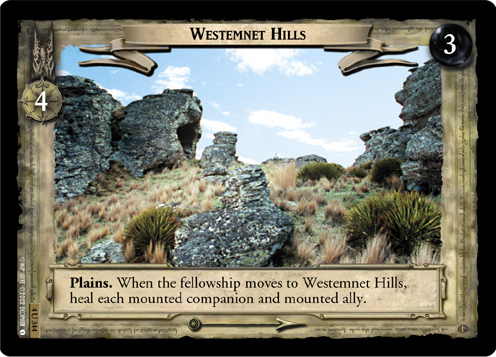
- Deep of Helm (4U347)
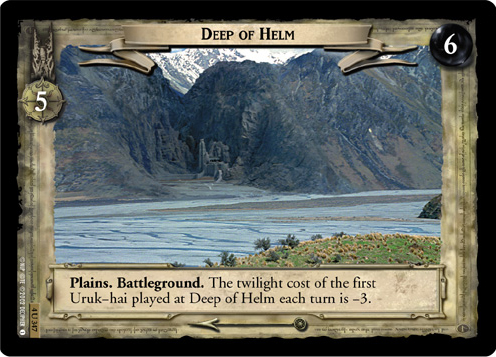
- Great Hall (4U353)
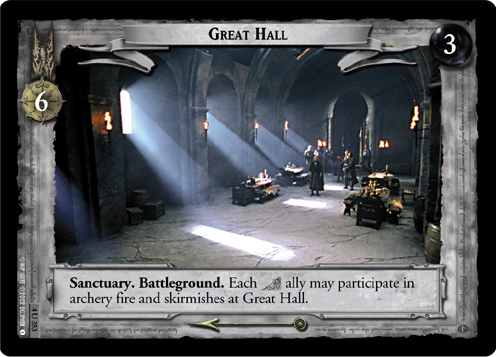
- King's Room (4U357)
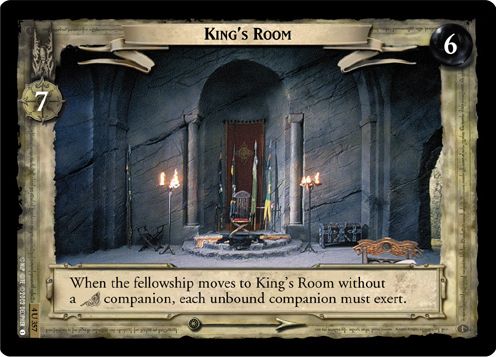
- Valley of Saruman (6U119)
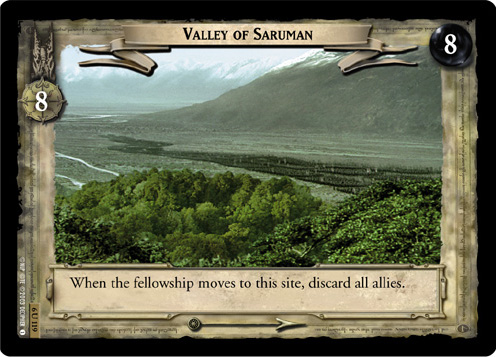
- Orthanc Balcony (4U361)
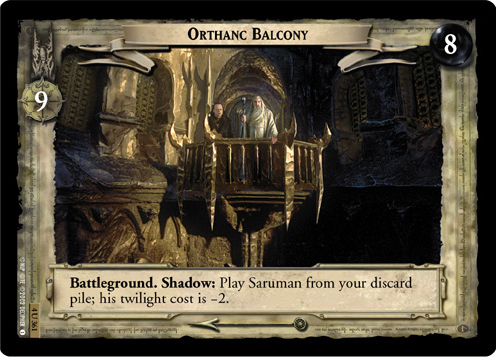
Free Peoples Draw Deck:
- 1x Legolas, Greenleaf (1R50)
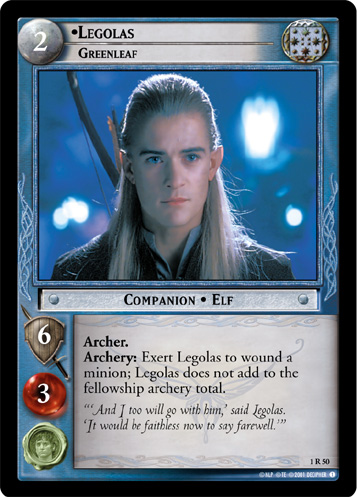
- 1x Aragorn, Ranger of the North (1R89)
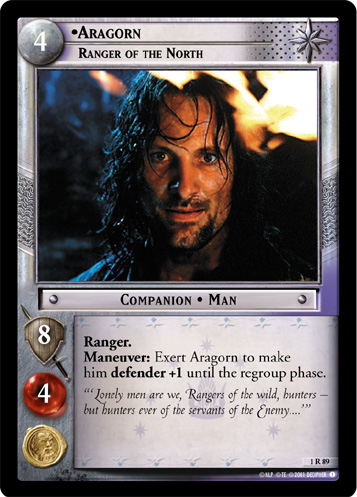
- 1x Elite Rider (4C265)
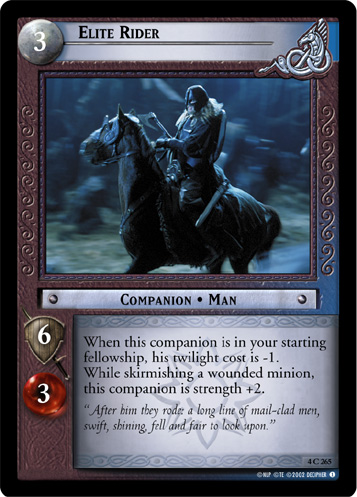
- 1x Hrethel, Rider of Rohan (6C95)
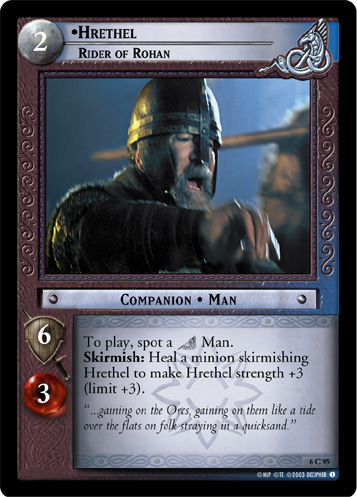
- 1x Éomer, Third Marshal of Riddermark (4R267)
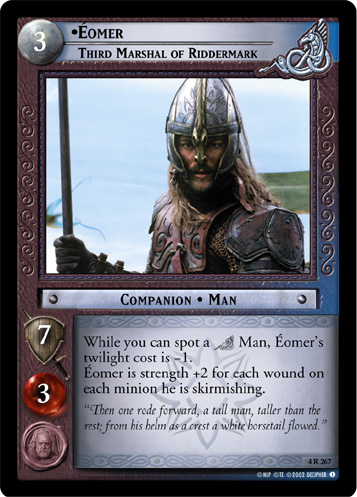
- 1x Éowyn, Lady of Rohan (4C270)
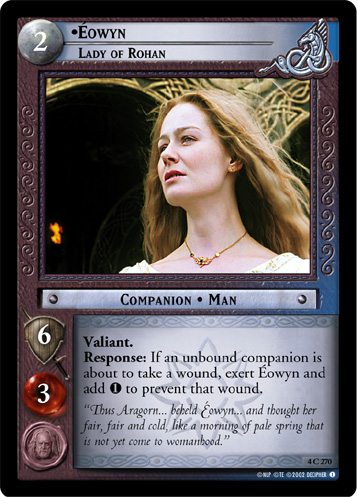
- 1x Sam, Proper Poet (2C114)
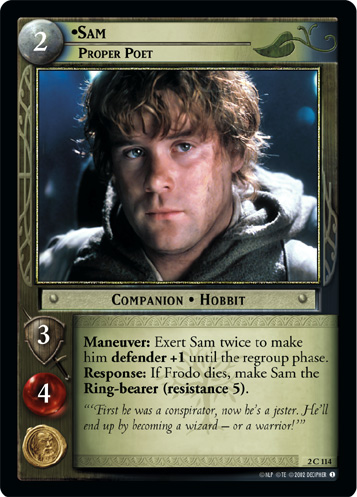
- 1x Hlafwine, Village Farmhand (4C281)
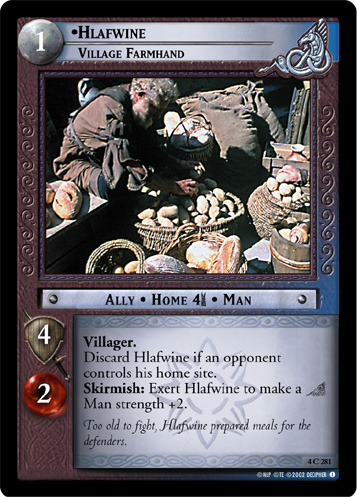
- 1x Léod, Westfold Herdsman (4U285)
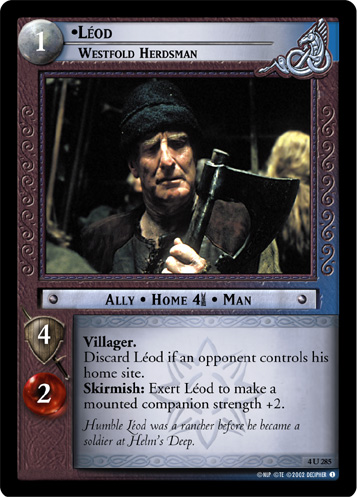
- 1x Brego (4U263)
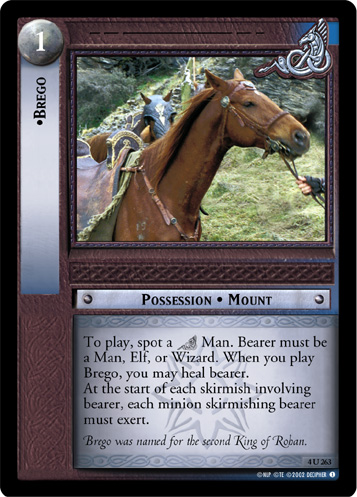
- 1x Éomer's Spear (4U268)
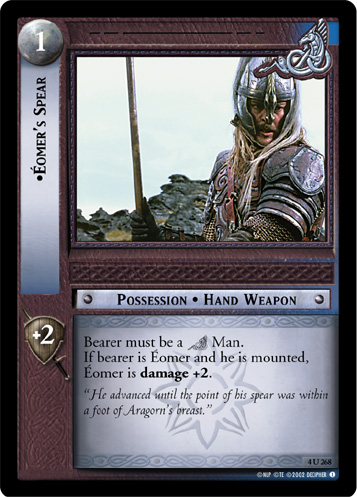
- 1x Firefoot (4R274)
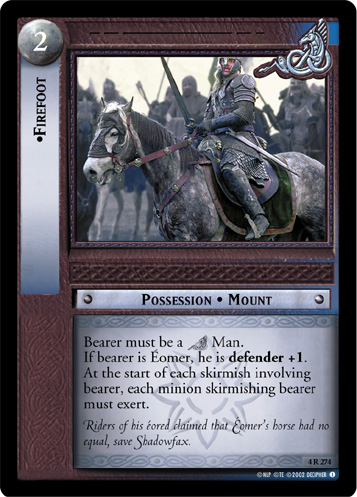
- 1x Rider's Mount (4C287)
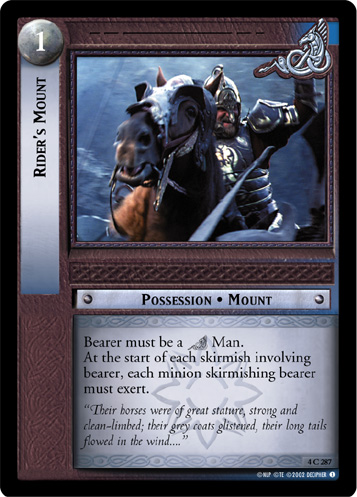
- 2x Rider's Spear (4C288)
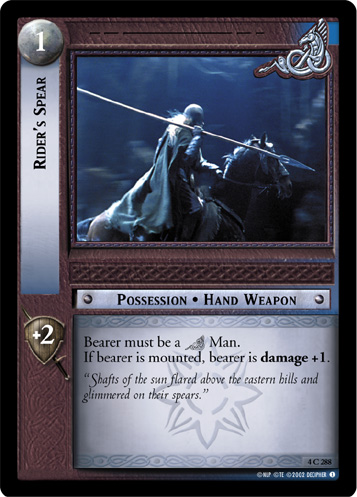
- 1x Rohirrim Bow (5C88)
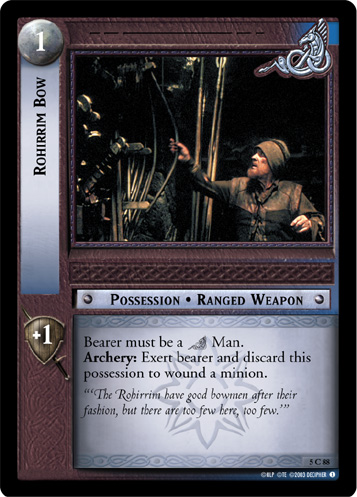
- 1x Frying Pan (3C108)
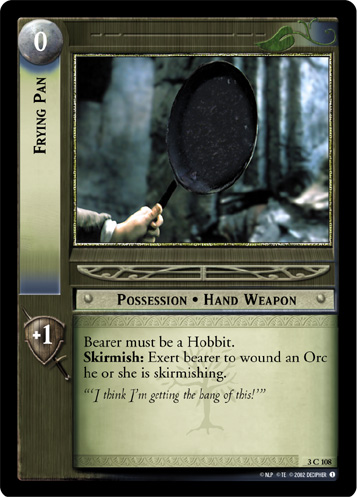
- 2x An Honorable Charge (4U282)
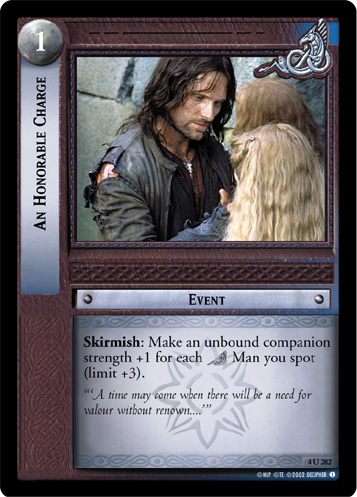
- 4x Simbelmynë (4R289)
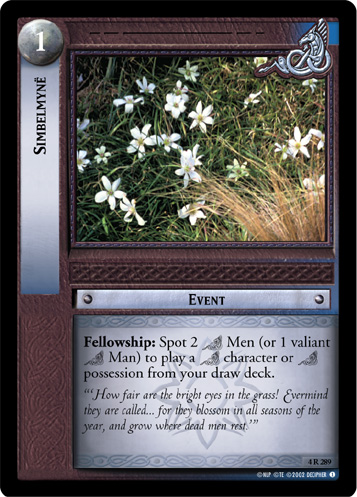
- 3x Arrow-slits (5U80)
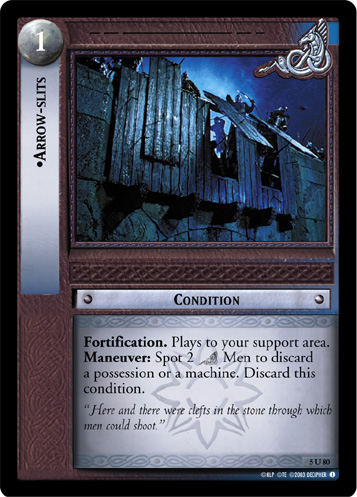
- 2x Fortress Never Fallen (4U276)
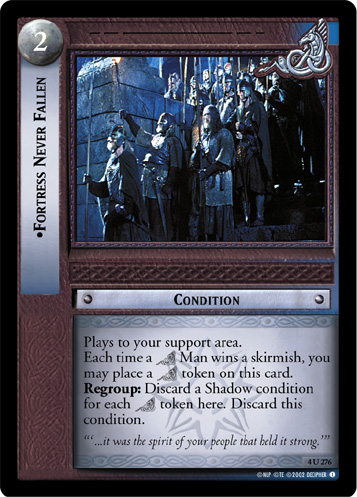
- 3x Thundering Host (5R94)
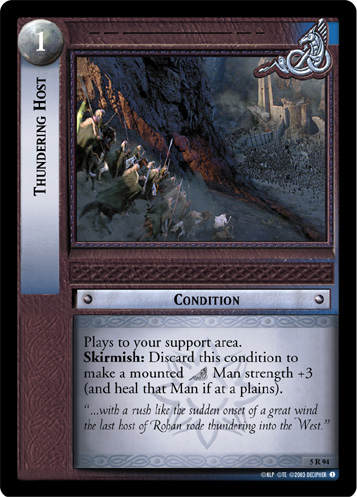
- 1x We Left None Alive (6C97)
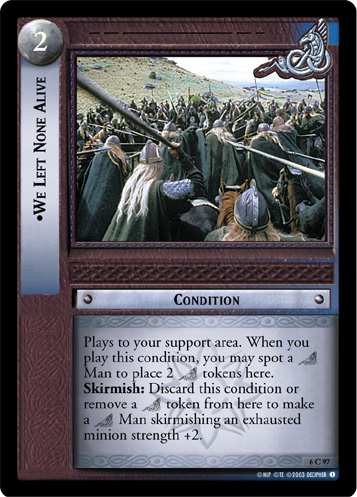
Shadow Draw Deck:
- 3x Lurtz, Servant of Isengard (1R127)
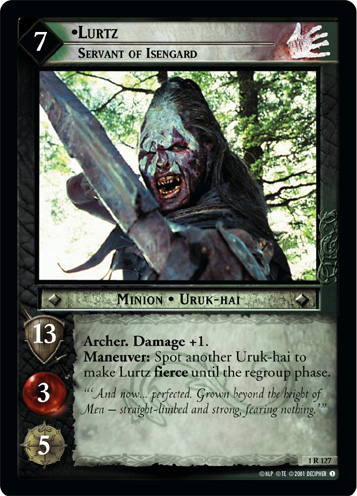
- 3x Mauhúr, Patrol Leader (4R160)
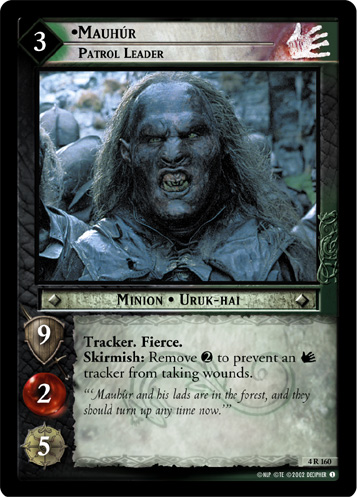
- 2x Saruman, Black Traitor (4R173)
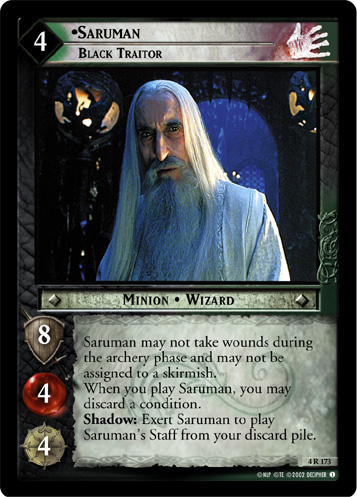
- 2x Saruman, Servant of the Eye (3C69)

- 3x Uglúk, Servant of Saruman (4R176)

- 4x Uruk Chaser (4C181)
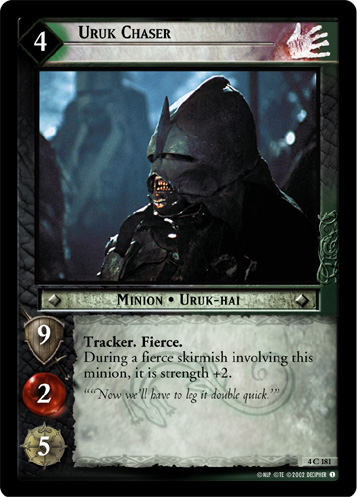
- 1x Uruk Hunter (4U188)
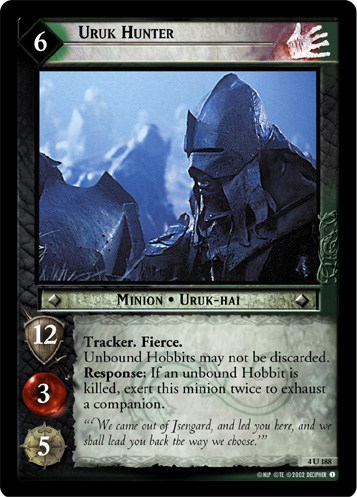
- 3x Uruk Runner (4C193)
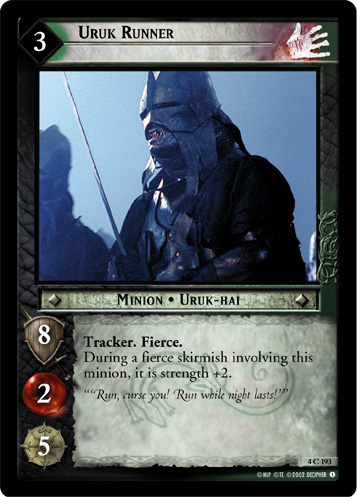
- 1x Úlairë Enquëa, Lieutenant of Morgul (1U231)
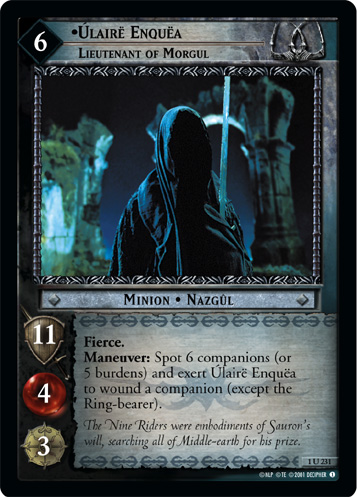
- 2x Broad-bladed Sword (4C142)
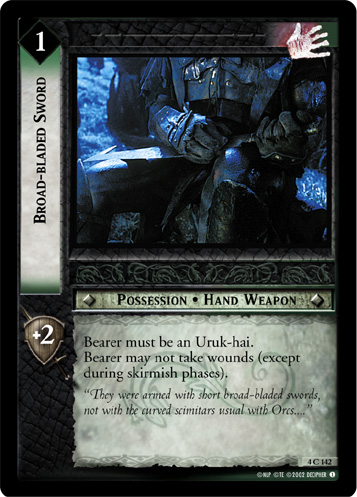
- 3x Uruk Spear (4C196)
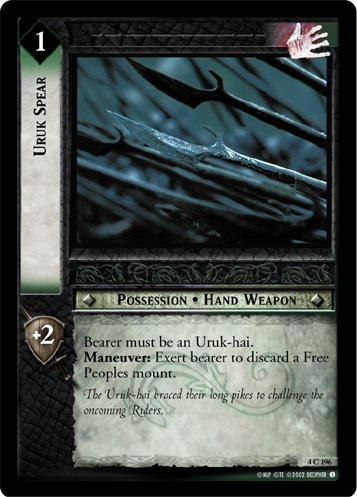
- 2x Saruman's Staff, Wizard's Device (4R174)
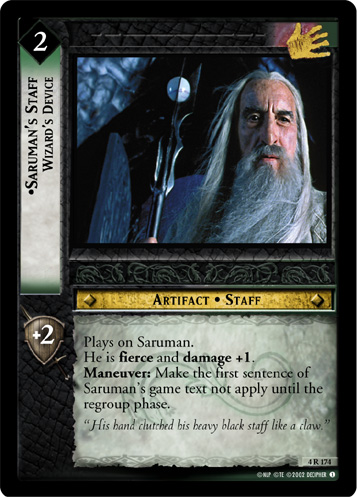
- 1x The Palantír of Orthanc (3R67)
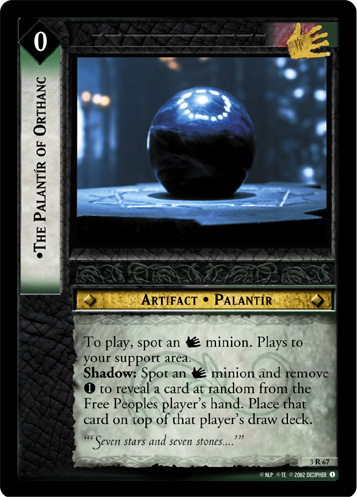
- 1x Saruman's Power (1U136)

- 1x What Did You Discover? (4R213)
